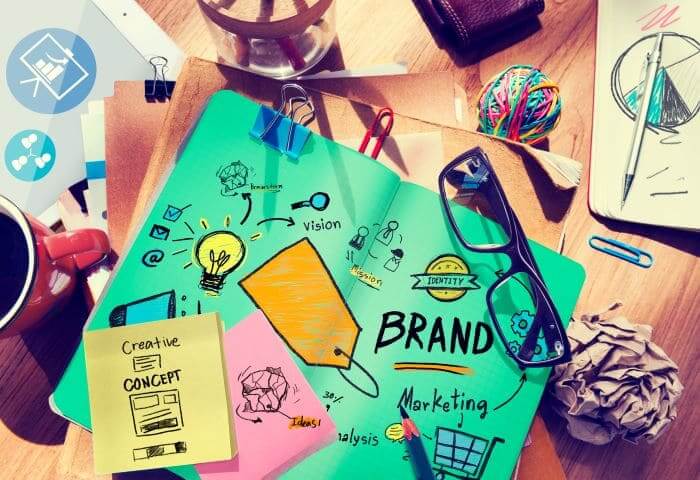A powerful brand identity is essential for companies aiming to leave a lasting impression on the market. Checkout The Ultimate Guide to Brand Assets.
Brand assets—the distinctive and identifiable elements that shape a brand’s visual, verbal, and experiential facets—hold the key to unlocking this potential.
Understanding and effectively employing brand assets can empower businesses to build recognition, establish trust, and nurture customer loyalty. Hence, it is invaluable in influencing public perception and driving long-term success.
This comprehensive guide explores the diverse types of brand assets and demonstrates how each contributes to forming a cohesive and captivating brand identity. In addition, strategies for leveraging these assets are discussed.
Table of Contents
What Are Brand Assets?

Brand assets are the distinctive and identifiable elements that compose a brand’s identity, contributing to its recognition, reputation, and overall perception in the market. These assets are crucial in differentiating a business from its competitors and fostering brand awareness, loyalty, and consumer trust.
Effectively managing and leveraging brand assets is essential for businesses seeking to create a strong brand presence, engage their target audience, and stand out in a competitive market.
However, developing a branding strategy from scratch can be challenging, as it requires time, money, and resources. Fortunately, you can visit professional sites such as mws.dev to contact experts that can help you every step of the way.
Types Of Brand Assets
Brand assets can be categorized into three primary types: visual, verbal, and experiential. Each category plays a unique role in building a brand’s identity, fostering recognition, and conveying the brand’s values and personality to consumers.
A comprehensive understanding of these categories and their respective elements enables businesses to create a robust and cohesive brand identity that resonates with their target audience.
1. Visual Brand Assets
These graphic elements form a brand’s visual identity, establishing a recognizable and consistent aesthetic across all marketing channels and differentiating the brand from competitors. Visual assets include:
Logos
These are distinctive symbols or designs that serve as the primary visual identifier for a brand, acting as the most immediate representation of the company in the minds of consumers.
A well-designed logo design should be memorable, versatile, and reflect the brand’s essence.
Color Palettes
These carefully selected sets of colors representing the brand evoke emotions and associations that align with the brand’s identity and message.
A consistent color palette helps to create a strong visual identity, making the brand easily recognizable and ensuring harmony across all marketing materials.
Typography
The selection and use of fonts and typographic styles in brand communications play a significant role in shaping the visual perception and character of the brand.
Typography choices should complement the brand’s identity, enhance readability, and contribute to a cohesive visual language.
Imagery And Photography
The consistent use of visual content, such as photos, illustrations, or graphics that effectively showcases the brand’s personality, products, or services.
Imagery and photography should create a unified visual language, resonate with the target audience, and reinforce the brand’s identity across various platforms.
Packaging And Product Design
Thoughtful incorporation of design elements into products or packaging that reflect the brand’s identity, influencing customer perception and enhancing the overall user experience.
Packaging and product design should be visually appealing, functional, and consistent with the brand’s visual language, making a lasting impression on consumers.
Visual brand assets provide a consistent and recognizable aesthetic for a brand, enabling it to differentiate itself in the market and establish a strong visual identity that resonates with consumers.
2. Verbal Brand Assets
These assets involve the language and messaging used in brand communications. They convey the brand’s voice, personality, and values, fostering an emotional connection with consumers. Verbal brand assets include:
Taglines And Slogans
These are distinctive and memorable phrases that expertly encapsulate the brand’s essence, value proposition, or promise to customers.
These brief yet powerful statements serve to make the brand instantly recognizable and memorable, fostering a connection with the target audience and setting the brand apart from its competitors.
Tone Of Voice
This is the unique and carefully crafted style of communication adopted by the brand, which effectively reflects its personality, values, and positioning in the market.
Brand Stories and Narratives
These are engaging and compelling stories that delve into the brand’s history, mission, vision, or purpose. It provides consumers with a deeper understanding of the core values and motivations behind the company.
By sharing these narratives through various channels and formats, brands can foster emotional connections, humanize their image, and inspire loyalty and advocacy among their audience.
Verbal brand assets effectively foster emotional connections with consumers and enhance the overall impact of the brand’s messaging.
3. Experiential Brand Assets
These assets pertain to the overall experience consumers have when interacting with a brand, whether through its products, services, or marketing initiatives. Experiential assets are crucial in fostering memorable and positive associations with the brand. Examples of experiential brand assets include:
Customer Service
The exceptional quality and unwavering consistency of a brand’s customer support plays a pivotal role in shaping consumer perception, satisfaction, and loyalty.
Customer service serves as a crucial touchpoint in the customer journey, offering businesses the opportunity to address concerns, provide solutions, and create positive and memorable experiences that encourage repeat business and long-term relationships.
User Experience (UX) Design
This is the thoughtful and intentional design of digital interfaces, such as websites or mobile apps, which directly impacts the way users interact with the brand.
UX design encompasses a range of elements, including navigation, layout, and content, all of which contribute to creating a seamless, intuitive, and enjoyable experience for users. This, in turn, fosters customer satisfaction, positive brand associations, and increased engagement.
In-store Or Event Experiences
This is the immersive and engaging design of physical spaces or events that transport consumers into the brand’s world, captivating their senses and emotions while reinforcing the brand’s identity and values.
These experiences can range from innovative store layouts and interactive displays to memorable events and activations that showcase the brand’s products, services, or unique selling points.
By creating such experiences, businesses can establish deeper connections with their target audience, inspire loyalty, and elevate their brand’s standing in the market.
A well-rounded brand strategy effectively combines visual, verbal, and experiential assets to create a cohesive and compelling brand identity. By synergistically integrating these elements, businesses can resonate with their target audience, differentiate themselves from competitors, and thrive in the competitive market.
Leveraging Your Brand Assets
Businesses can capitalize on the potential of visual, verbal, and experiential brand assets by employing well-targeted strategies to amplify their brand presence, foster meaningful connections with consumers, and stimulate growth.
Here are some comprehensive methods to optimize your brand assets and drive your business forward.
Practice Consistency Across Channels
Ensure all marketing materials, digital platforms, and print media consistently adhere to brand guidelines for logos, color palettes, typography, and imagery. Consistency reinforces brand recognition and cultivates a unified and cohesive brand experience that consumers appreciate and trust.
Embrace Evolution and Refresh Your Brand’s Image
Regularly review and update visual assets to maintain relevance, modernity, and engagement while preserving the essential elements that define the brand. Adapting to evolving market conditions and consumer preferences keeps the brand fresh and appealing, enhancing its ability to thrive in a competitive landscape.
Forge Collaborations and Partnerships
Collaborate with influencers, designers, or other brands to co-create limited edition products or marketing campaigns that complement your brand’s visual identity. By joining forces with others, you can expand your reach, attract new audiences, and benefit from the synergy of combined creativity and expertise.
Offer Customization Options
Provide customers with the ability to personalize products or packaging using colors, patterns, or imagery that align with your brand’s visual guidelines. Customization enhances customer engagement and loyalty and allows your brand to stand out by offering unique and memorable experiences.
Leverage Storytelling
Leverage compelling brand stories and narratives to foster emotional connections with consumers, humanize the brand, and communicate its purpose or vision. Share these stories across various platforms, such as blog posts, videos, or social media content, to engage with your audience on a deeper level and inspire brand loyalty.
Diversify Your Content Marketing Approach
Create valuable, informative and engaging content that showcases your brand’s voice and expertise. Employ various formats such as blog posts, whitepapers, podcasts, or videos to demonstrate your brand’s knowledge and authority. Consistency in tone of voice and messaging across these formats helps strengthen your brand identity and appeal to a broader audience.
Actively Engage on Social Media
Interact with your audience on social media platforms using your brand’s unique voice. Foster a sense of community and brand loyalty by responding to comments, asking questions, and sharing user-generated content that aligns with your brand’s verbal identity. Social media also provides an invaluable opportunity to gather feedback and gain insights into consumer preferences and concerns.
Use Customer Service as a Competitive Advantage
Focus on exceptional customer service by offering timely, empathetic, and solution-driven support. Well-trained customer-facing employees who embody the brand’s values and uphold verbal and experiential consistency guarantee a seamless customer experience, setting your brand apart from competitors and driving customer satisfaction and loyalty.
Design Immersive Experiences
Craft captivating in-store or event experiences that mirror the brand’s identity and immerse consumers in the brand’s world. Achieve this through interactive displays, innovative store layouts, or memorable events that showcase your brand’s products or services, resonating with your target audience and creating lasting impressions.
Encourage User-Generated Content
Motivate customers to share their experiences with your brand through user-generated content such as reviews, testimonials, or social media posts. This strategy not only reinforces positive associations with your brand but also offers valuable social proof that can influence potential customers’ decision-making processes.
By implementing these strategies, businesses can effectively leverage their visual, verbal, and experiential brand assets to strengthen their brand presence, engage their target audience, and achieve a competitive advantage in the market.
The Bottom Line
Brand assets are the elements that represent your brand and set it apart from competitors. Therefore, building solid brand assets can help you create a consistent and memorable brand experience. It also increases your brand awareness, thus increasing customer loyalty and engagement.
Further Reading:
- 10 Examples of Powerful Global Branding
- Learning from the World’s Most Famous Logos
- Best Global Rebrands and Logo Redesigns of Major Brands
- Branding Beyond Borders: Elevating Your Global Presence through Impactful Logo Design
- Logo Design Trends to Watch Out for in 2023: Stay Ahead of the Curve!
- Most Expensive Logos In The World
- Every Good Logo Tells a Story! 40 Famous Brand Logos & Their Hidden Secrets
- Famous Logo Designers and Their Distinctive Style
- Using the Golden Ratio in Logo Design
- 20 Famous Brand Logos Constructed in Grid Systems
Join The Logo Community
We hope you enjoyed this article about Logo Evolution: How Famous Logos Evolved Over Time. If you would like more personal tips, advice, insights, and access to our community threads and other goodies, join me in our community. You can comment directly on posts and have a discussion.
*TIP – We use and recommend DesignCuts for all your fonts, mockups and design bundles.


